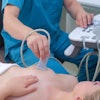Dear Ultrasound Insider,
Point-of-care ultrasound has been shown to offer comparable accuracy to conventional ultrasound for a few specific clinical indications. But the technique can also perform well in a number of general abdominal, renal, and obstetric applications, according to a paper published recently in the Journal of Ultrasound in Medicine.
In a study involving nearly 50 patients, researchers from Dartmouth-Hitchcock Medical Center in Lebanon, NH, found that conventional ultrasound had only modestly higher overall accuracy than point-of-care ultrasound. The findings highlight the potential of point-of-care ultrasound in low-resource settings, according to the authors.
Our coverage of the research is this newsletter's Insider Exclusive, which you can access before our regular members.
We also have the next edition in our new article series on right heart quantification by consulting firm CardioServ. In Part 2, CardioServ Clinical Cardiac Director Andrea Fields reviews the proper methods for quantifying the right heart for both size and function.
In other news in this issue, a 3D vascular ultrasound method was found to reliably quantify plaque burden from subclinical atherosclerosis. The researchers also concluded that the technique more closely reflected estimated cardiovascular risk, compared with just the presence of plaque alone. Click here for all of the details.
Subclinical carotid atherosclerosis was also reported to negatively affect cognitive performance in individuals who carry a genotype known to increase the risk of developing Alzheimer's disease. Click here to learn more.
Adding elastography and color Doppler to B-mode ultrasound can significantly lower the number of false positives when screening women with dense breasts, according to a Korean research group. How many unnecessary biopsies could be avoided? Click here to find out.
Speaking of elastography, a Chinese team recently determined that a shear-wave method can be used to evaluate the stability of carotid plaques, helping to identify those that are most vulnerable to rupturing and causing a stroke.
A recent study also concluded that a focused assessment with sonography for trauma (FAST) exam may not improve the clinical care of hemodynamically stable children who have blunt trauma to the torso.
Is there a topic you'd like to see covered in your Ultrasound Digital Community? As always, please feel free to drop me a line.




















